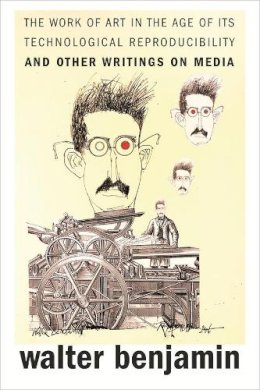
Stock image for illustration purposes only - book cover, edition or condition may vary.
The Work of Art in the Age of Its Technological Reproducibility, and Other Writings on Media
Walter Benjamin
€ 34.61
FREE Delivery in Ireland
Description for The Work of Art in the Age of Its Technological Reproducibility, and Other Writings on Media
Paperback. Addresses the utopian developments of the modern media. This collection tracks the author's observations on the media as they are revealed in essays on the production and reception of art; on film, radio, and photography; and on the modern transformations of literature and painting. Editor(s): Jennings, Michael W.; Doherty, Brigid; Levin, Thomas Y. Translator(s): Jephcott, Edmund; Livingstone, Rodney; Eiland, Howard. Num Pages: 448 pages, 22 halftones. BIC Classification: HPCF; JFD. Category: (P) Professional & Vocational. Dimension: 234 x 159 x 30. Weight in Grams: 652.
Read more
Walter Benjamin’s famous “Work of Art” essay sets out his boldest thoughts—on media and on culture in general—in their most realized form, while retaining an edge that gets under the skin of everyone who reads it. In this essay the visual arts of the machine age morph into literature and theory and then back again to images, gestures, and thought.
...
Product Details
Publisher
Harvard University Press
Number of pages
448
Format
Paperback
Publication date
2008
Condition
New
Weight
652g
Number of Pages
448
Place of Publication
Cambridge, Mass., United States
ISBN
9780674024458
SKU
V9780674024458
Shipping Time
Usually ships in 4 to 8 working days
Ref
99-1
About Walter Benjamin
Walter Benjamin (1892–1940) was the author of many works of literary and cultural analysis. Michael W. Jennings is Class of 1900 Professor of Modern Languages at Princeton University. Brigid Doherty is Associate Professor of German and of Art and Archaeology, Princeton University. Thomas Y. Levin is Associate Professor of German at Princeton University.
Reviews for The Work of Art in the Age of Its Technological Reproducibility, and Other Writings on Media
Until recently, Walter Benjamin’s seminal essay, The Work of Art in the Age of Its Technological Reproducibility, was available to English-speaking readers only in the version that appeared in the 1968 collection Illuminations. Harvard’s new volume of the German cultural critic’s writings on media offers as its title-piece an earlier, edgier incarnation—the second of three composed between 1935 and 1939—in...
Read more